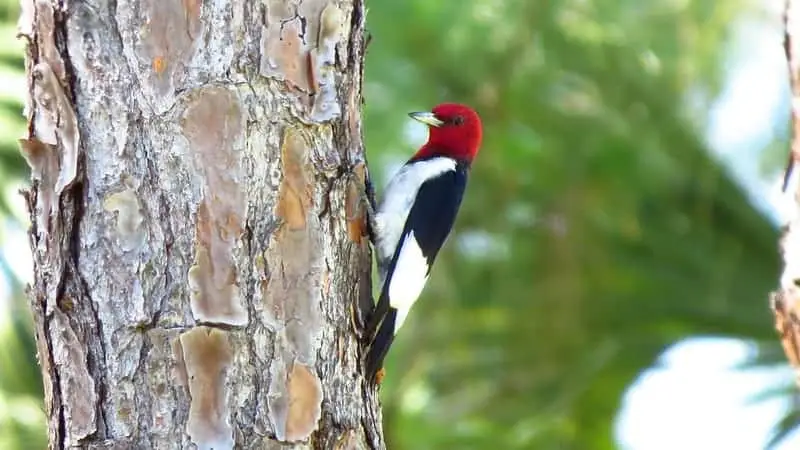
Want to learn more? Take a look at the North American Guide to Woodpeckers
The most commonly occurring woodpecker species is the downy woodpecker.
These woodpeckers all enjoy varying climates and habitats.
For example, many of them are cavity nesters, meaning that they dwell in the cavities of trees. The woodpeckers have a remarkable ability to excavate their own home within trees.
Certain habitats within Ohio are more attractive to woodpecker life, such as coniferous forests, swamp land, and even suburban areas if you’re lucky.
Woodpeckers are also different from many Ohio birds in that you can see many of them throughout the winter – no vacation to Florida for these tough species.
This makes them of particular interest to Ohio bird watchers who don’t have many options throughout the winter (other than the Cardinal bird!)
Some great trails and parks to view woodpeckers in Ohio include, but are not limited to
– Gazebo Trail at Mohican State Park
– Cuyahoga Valley National Park
Ohio’s large amount of wooded areas and suburban areas offer a lot of available habitats for local woodpeckers, and a lot of great opportunities for local bird watchers. Here are the seven species of common woodpecker species in Ohio.
Take a look at our article on How to Attract Woodpeckers?
What Woodpeckers can be seen in Ohio?
Table of Contents
1. Red-bellied Woodpecker
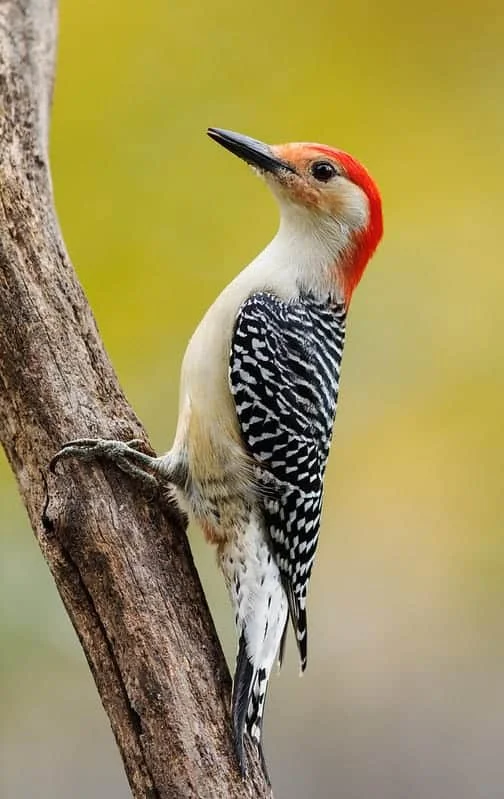
Wingspan
15-18 inches
Weight
2.65 ounces
Life Expectancy
12 years
Diet
Insects
Red-bellied woodpeckers arguably go against their name in a confusing manner.
Red-bellied woodpeckers have hardly identifiable red hues to their bellies, and what’s more, the male red-bellied woodpeckers have red heads.
This can cause some amateur bird watchers to label them as red-headed, since their bellies hardly look red sometimes.
The rest of their body is an interesting crosshatch of black and white stripes. They get their name from a slightly tinted area on their bellies that looks like someone rubbed blush on them.
They prefer to stay in deciduous forests or suburban areas and are commonly attracted to bird feeders, particularly containing peanuts and sunflower seeds.
They are one of the most common types of woodpeckers and are seen all over Ohio during all seasons.
Each year, researchers and bird watchers have noted that their range extends further to the north. Their call is also unique enough that once you hear it, you will remember it, so take a few seconds to give it a listen.
When can this bird be seen in the state?
Red-bellied woodpeckers can be seen in Ohio throughout the entirety of the year. They are not migratory birds.
Where can this bird be seen in the state?
The red-bellied woodpecker can be found anywhere in Ohio and they live and breed in Ohio. They will be found near deciduous trees or local bird feeders that contain peanuts and sunflower seeds. In the winter they take to suet feeders.
2. Downy Woodpecker
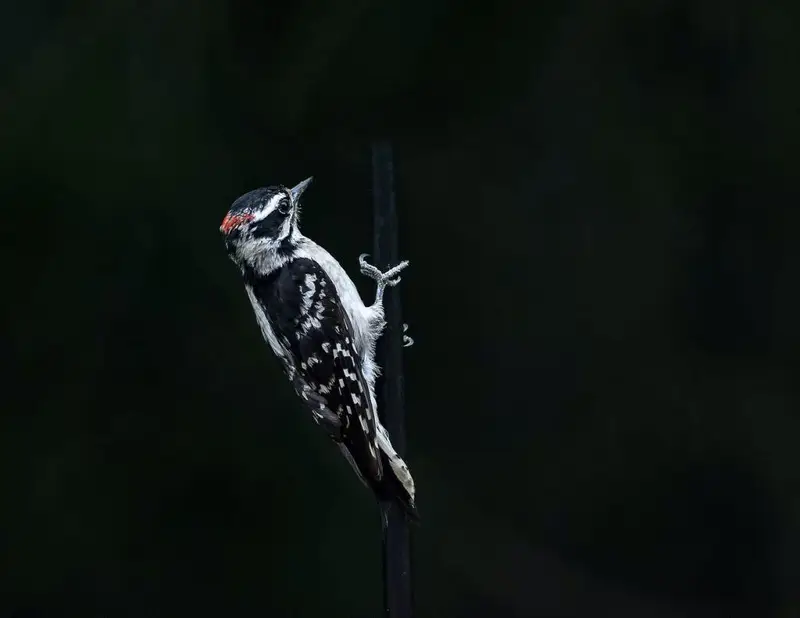
Wingspan
3-4 inches
Weight
1 ounces
Life Expectancy
12 years
Diet
Insects
The smallest and largest woodpeckers in North America both live in Ohio, and downy woodpeckers are on the small end of that duality.
Downy woodpeckers are black and white, with two black columns on either side of their upper back, with a large white swath in the middle. Their wings feature swirls of white spots on black.
Male downy woodpeckers will have a red spot on the rear of their neck. In Ohio, downy woodpeckers like to stay in deciduous forests, as opposed to downy woodpeckers that live in the southern United States that prefer homes near rivers.
Downy woodpeckers are the most populous woodpeckers in Ohio, so you can see them anywhere and anytime.
They are cavity nesters and since they are so small, they usually opt for holes dug into tree limbs, since they do not require enough space to justify burrowing into a tree trunk.
When can this bird be seen in the state?
Downy woodpeckers can be found in Ohio throughout the entire year. They breed and live in Ohio and are not migratory.
Where can this bird be seen in the state?
Downy woodpeckers can be seen all over the state of Ohio. They will be near deciduous trees and live in tree limbs most often. They are the most common species in Ohio, so you should be able to find them easily.
3. Hairy Woodpecker
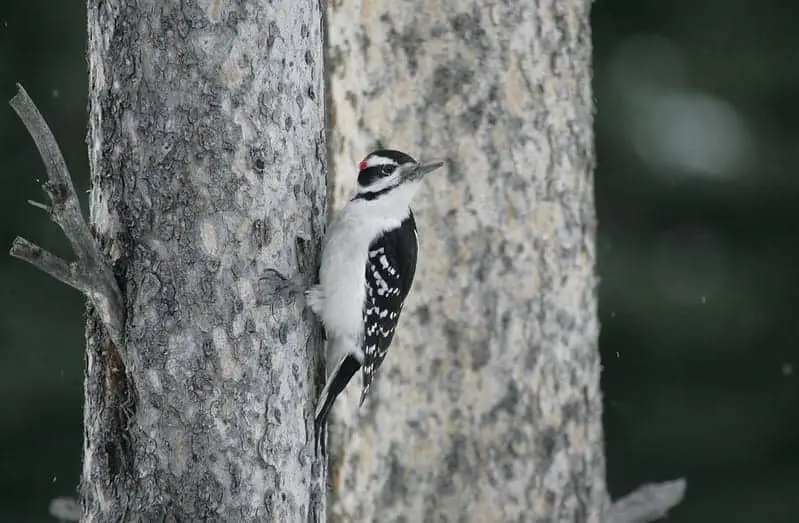
Wingspan
15 inches
Weight
1-3 ounces
Life Expectancy
15 years
Diet
Wood-boring insects & tree sap
Hairy woodpeckers are interesting due to their striking resemblance to downy woodpeckers. If you are having trouble distinguishing between the two species, as many bird watchers do, there are a few hints that might be able to tip you off.
First, hairy woodpeckers are larger than downy woodpeckers and due to their larger size, they frequently nest and eat insects from larger trees.
Also, hairy woodpeckers have a seemingly endless supply of energy when it comes to feeding, and they are known to dig deep into trees to fish out their prized food source, larvae of wood-boring insects.
So, if you think you are seeing a large and energetic downy woodpecker, you are probably actually seeing a hairy woodpecker.
They also have a wider range than downy woodpeckers and can be found all over the United States and Canada, aside from extreme northern Canada, and extreme southern United States.
When can this bird be seen in the state?
Hairy woodpeckers can be found in Ohio throughout all seasons. They are not migratory, although if the weather gets harsh enough, they might take a trip further south to seek more comfortable conditions, but this is not a pre-programmed trip that they take each year.
Where can this bird be seen in the state?
Hairy woodpeckers can be seen all over Ohio and are relatively common, although their population has been decreasing. They do need large trees to dig for insects and to build cavities to nest in.
4. Pileated Woodpecker
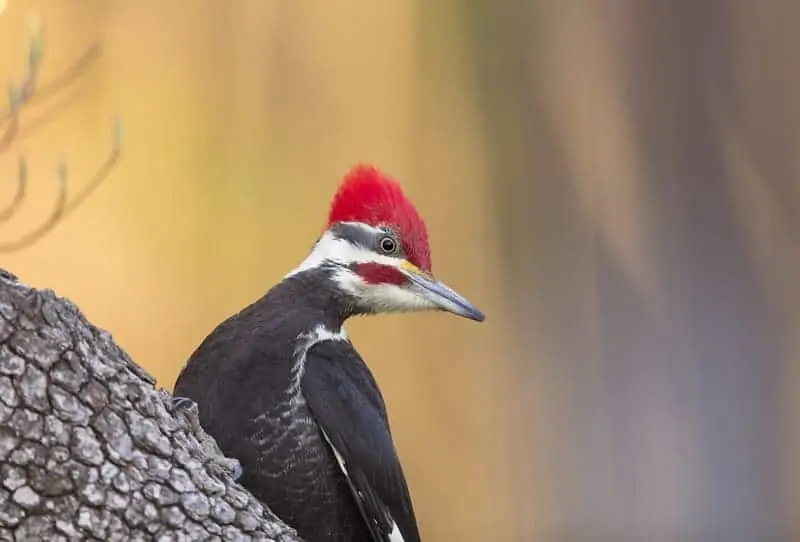
Wingspan
26-30 inches
Weight
8-14 ounces
Life Expectancy
13 years
Diet
Insects, fruits and nuts
It was mentioned earlier that Ohio is home to both the largest and smallest (Downy Woodpecker) woodpecker species in North America, and pileated woodpeckers are the giants of North America.
In addition to their incredible size, they have a large red plume on top of their heads that make them difficult to miss.
If you see a set of holes from a woodpecker in a tree and want to know if it’s from a pileated woodpecker, check the shape, if they are rectangular holes, you have a pileated woodpecker nearby.
They are one of the most aggressive excavators of all the North American woodpeckers and love to dig into dead trees for carpenter ants and termites.
Although they are slightly less common in Ohio than they are in the south eastern United States, you should be able to find them since they are so hard to miss when they’re nearby.
They also eat fruits and berries and are able to balance on small vines and bushes easier than you might think for a bird of their stature.
Their homes are easily identifiable too, since it takes a big hole to house such a large bird. The cartoon character Woody Woodpecker is based off this species.
When can this bird be seen in the state?
Pileated woodpeckers live in Ohio all year round. They are not migratory birds.
Where can this bird be seen in the state?
Pileated woodpeckers are found in all of Ohio. They are drawn to dead trees and have a call that sounds like laughing (think Woody Woodpecker), that gives away their location.
5. Yellow-bellied Sapsucker
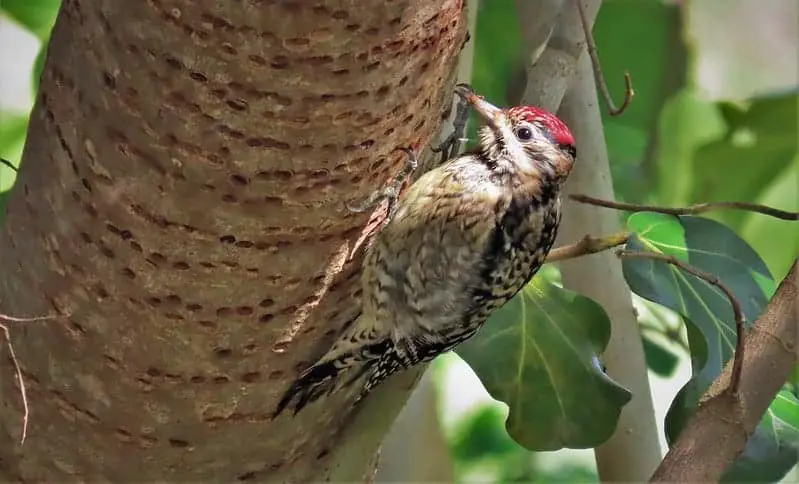
Wingspan
13-6 inches
Weight
2 ounces
Life Expectancy
7 years
Diet
Insects, tree sap & fruits
Yellow-bellied sapsuckers divide Ohio in half, with the northern half having sightings only due to migratory stops during the winter, and the southern half actually hosting some yellow-bellied sapsuckers at the end of their migratory journey.
Ohio is a rare place for sapsuckers to stop their migratory journey, many will continue as far south as Cuba or the Bahamas, but it is possible for them to take up residence in Cincinnati suburbs for the winter.
Yellow-bellied sapsuckers, as the name would suggest, feed mostly on sap that they retrieve from deciduous trees by drilling organized horizontal rows of holes that allow sap to drain out of the tree.
This sap will also attract insects to savour the same sweetness that the sapsuckers love, and these woodpeckers will feed on those insects as well.
Yellow-bellied sapsuckers will come back to the locations where they drew sap multiple times a day as sap continues to drain from the tree. They do not breed in Ohio, but rather they breed further north and then migrate south for the winter.
Yellow-bellied sapsuckers have yellow-tinted bellies and males have red throats, while females have yellow throats. The rest of their body is black and white spotted.
When can this bird be seen in the state?
Sapsuckers are migratory and will only be found in southwestern Ohio during the winter, they can be found passing through the rest of the state as they migrate.
Where can this bird be seen in the state?
Sapsuckers can be seen anywhere in the state, but they don’t breed in Ohio and only live for extended periods of time in the south western part of the state.
6. Northern Flicker
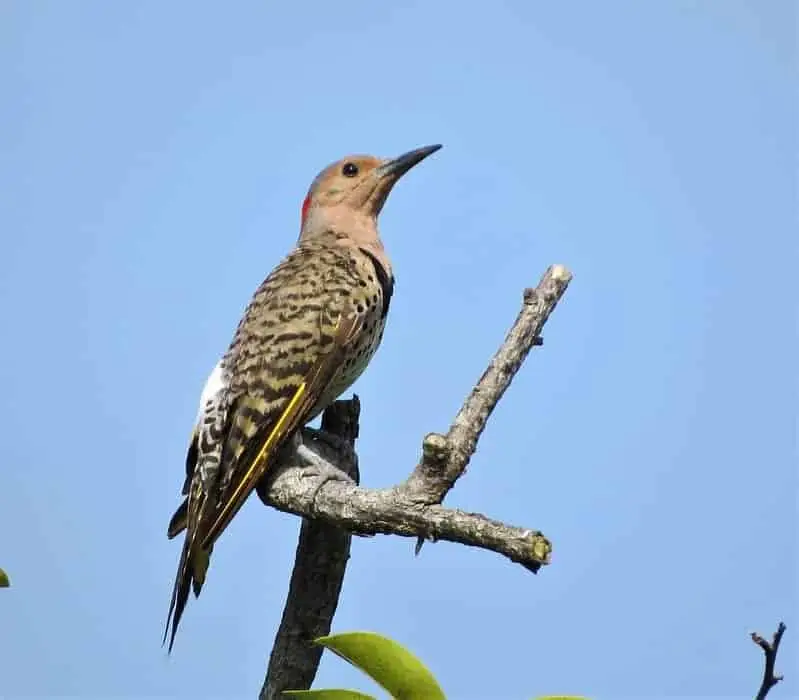
Wingspan
21 inches
Weight
6 ounces
Life Expectancy
9 years
Diet
Insects, fruit & nuts
Northern flickers are an unusual woodpecker species because they do not act like traditional woodpeckers. Rather than excavating trees to find bugs, northern flickers will hop along the ground to search for insects like ants.
They will occasionally drum on trees, but it is only for communication purposes and not to find insects. Northern flickers are found almost throughout all of the USA and Canada, and even parts of Mexico and Central America, which speaks to their ability to weather various climates.
The eastern version of northern flickers, which is the variety that is found in Ohio, has yellow on their tails along with the usual northern flicker markings of white bellies spotted with black dots, and a red spot on top of their head.
They are not anywhere near as large as a pileated woodpecker, but they are one of the larger woodpecker species around.
Where can this bird be seen in the state?
Northern flickers are found in Ohio during all seasons. This is because they easily adjust to cold or warm climates.
Where can this bird be seen in the state?
Northern flickers are found in all parts of Ohio, they have one of the largest ranges for North American woodpeckers.
7. Red-headed Woodpecker

Wingspan
16 inches
Weight
2.5 ounces
Life Expectancy
9 years
Diet
Insects & berries
Red-headed woodpeckers are some of the most striking woodpeckers in the world. Their entire head from the neck up is a pure crimson that catches the eye in contrast with their snow-white bellies and jet-black backs with white tipped wings.
They are one of the few woodpecker varieties that are aerial hunters. They will wait and search for flying insects to pass nearby from a tree branch and when the time is right, they will swoop in for the kill. They also gather nuts and seeds from the ground and will store them in their homes.
Since they gather from the ground frequently, they like to hang around orchards and farms, where there are lots of available seeds and flying bugs for them to feed on. They are also one of the few woodpecker varieties that travel in groups greater than two birds quite often.
When can this bird be seen in the state?
Red-headed woodpeckers are only found in Ohio throughout all seasons. They also breed in Ohio as well.
Where can this bird be seen in the state?
Red-headed woodpeckers can be found in all parts of Ohio. Look for them in orchards or tree farms, since they like clear ground with little foliage for them to forage for bugs and nuts and seeds.

More Articles.
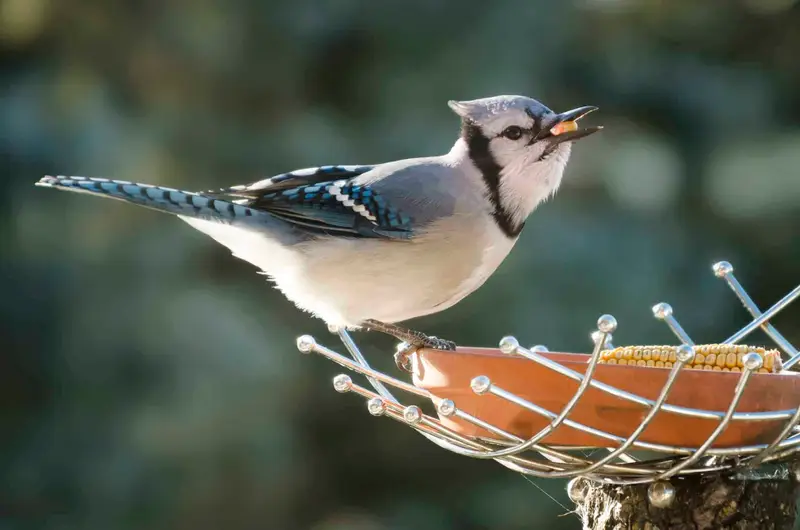
How to Attract Blue Jays to your Yard?
Some may vehemently argue that Blue Jays are the bullies of the bird kingdom and
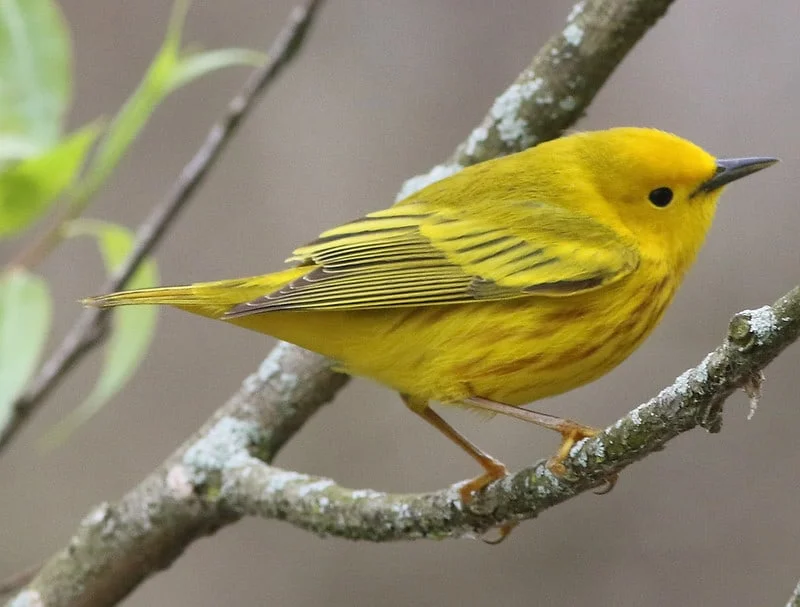
North American Birds with Yellow Wings (12 Species with Pictures and Sounds)
Canada and America are filled with many wonderful birds with yellow wings – in fact,
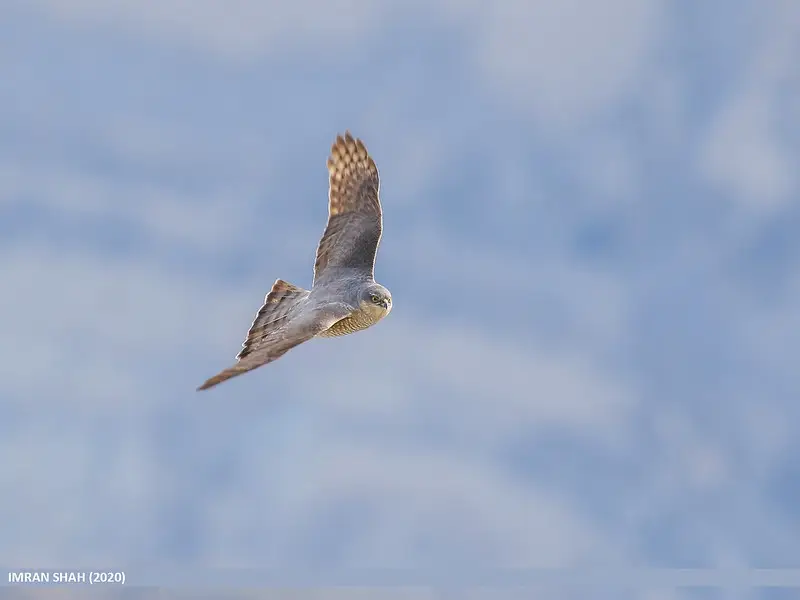
What Hawks can you see in Austria? (3 Species with Pictures & Sounds)
What Hawks can you see in Austria? There are 3 different species of Hawks that

About Us
We are avid bird-watchers who recently retired, allowing us more time to travel the world. Fortunately, we have managed to visit numerous countries around Europe, Asia, and America. Watching and photographing birds has been a passion for many years and we are making the most of the extra time on our hands!

I have two kinds , red bellied and downy wood peckers here is Southern Ohio
I am just south of Lancaster Ohio. Yesterday I saw a pileated woodpecker, as well as a red headed, a downy and a red bellied woodpecker all within about 15 minutes. In fact, they all (individually) came to eat from my suet feeder that I have hanging on my deck. I was amazed that even the pileated woodpecker ate from the feeder.